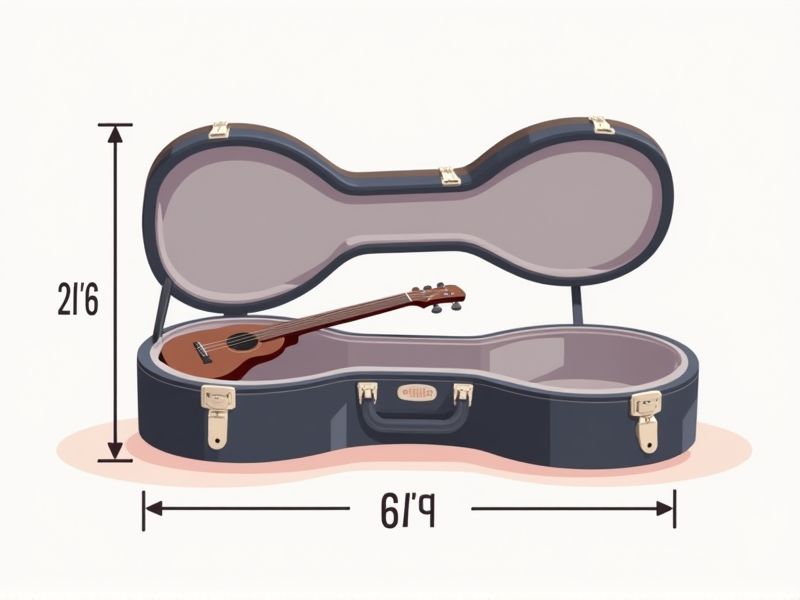
When choosing a guitar case, it's helpful to know the standard dimensions to ensure a proper fit for your instrument. For a typical acoustic guitar, standard case interior dimensions are roughly 41-42 inches long, 16-17 inches wide at the lower bout, 12-13 inches at the upper bout, and around 5-6 inches deep. Electric guitar cases, such as for a Stratocaster or Les Paul, generally range from 39-40 inches long, with widths around 13-15 inches and depths of about 3-4 inches. Always check your guitar's measurements and consult the manufacturer's specifications to make sure your case will provide the best protection.
Length Of The Guitar
The standard guitar case dimensions are primarily influenced by the length of the guitar, which typically ranges from 39 to 41 inches for a full-sized acoustic guitar. A well-fitted guitar case should aim for an interior length of approximately 41.5 inches to accommodate this standard size comfortably. Ensuring your case has a snug fit protects the guitar from damage and reduces unnecessary movement during transportation. By considering measurements such as depth and width, you can select a case that not only fits your guitar but also provides adequate protection against impacts and environmental factors.
Width Of The Guitar
The standard guitar case dimensions typically account for a width of 15 to 18 inches, suitable for most acoustic and electric guitars. Cases are designed to provide a snug fit, ensuring minimal movement and optimal protection during transport. Choosing a case that matches your guitar's width ensures adequate support for the body and neck, preventing damage from impacts. Always check the manufacturer's specifications to confirm compatibility with your specific guitar model.
Thickness Of The Guitar Body
The standard thickness of a guitar body typically ranges from 3 to 5 inches, depending on the type of guitar. For instance, acoustic guitars often feature a thicker body for enhanced sound projection, while electric guitars may have a thinner profile for easier handling. When selecting a guitar case, ensure that it accommodates the specific thickness of your guitar body to prevent any damage. Your investment in a well-fitted case can significantly extend the lifespan of your instrument, protecting it from environmental factors and physical impacts.
Neck Length
A standard guitar case typically accommodates neck lengths ranging from 24.75 inches to 25.5 inches, essential for ensuring proper fit and protection. Most cases are designed with a snug interior, minimizing movement and reducing the risk of damage during transport. When selecting a guitar case, ensure that the dimensions correspond with your guitar's specifications, as this can enhance durability and longevity. Understanding these measurements is crucial for maintaining your instrument's condition, enabling you to play with confidence.
Headstock Space
When selecting a guitar case, the headstock space is crucial for preventing damage during transport. An ideal case should provide at least 1 inch of padding around the headstock area, ensuring it remains secure and protected from impacts. Many cases come equipped with specially designed neck supports that elevate the guitar, minimizing pressure on the headstock. Consider cases made from high-quality materials, such as hard-shell or molded options, which offer superior protection and durability.
Depth Of The Case
When selecting a guitar case, the depth of the case is a critical factor that directly influences the instrument's protection and fit. Standard guitar cases vary in depth, typically ranging from 4 to 6 inches, depending on the type of guitar--acoustic, electric, or bass. A well-fitted case ensures that the guitar remains stable during transport, reducing the risk of damage from impacts or vibrations. Consider measuring your guitar's body to ensure the case depth accommodates it comfortably, enhancing both its safety and portability.
Extra Accessory Compartment
A high-quality guitar case should feature an extra accessory compartment that provides ample storage space for essential items such as picks, straps, and tuners. Typically, this compartment measures around 12 to 15 inches in length, ensuring a snug fit for various accessories without compromising the case's overall design. Look for cases made from durable materials, such as hardshell or molded foam, to protect your gear. A well-designed accessory compartment not only enhances organization but also contributes to the longevity of your instrument by keeping everything in one secure location.
Type Of Guitar (Acoustic, Electric, Bass)
When selecting a guitar case, it's essential to consider the type of guitar you own: acoustic, electric, or bass. Acoustic guitar cases typically feature plush interiors and a snug fit to protect the instrument's body and neck, while electric guitar cases often have a more streamlined design, accommodating various body shapes and sizes. Bass guitar cases are usually larger, ensuring ample space for the extended length of the instrument. Investing in a case tailored to your guitar type enhances protection against environmental factors and transportation wear, prolonging your instrument's lifespan.
Material Of The Case
A high-quality guitar case typically features an exterior constructed from durable materials such as plywood or molded plastic, ensuring superior protection against physical damage. The interior is often lined with soft fabrics like plush velvet or foam, safeguarding your instrument from scratches and impact. Moreover, a standard case may weigh between 5 to 10 pounds, balancing portability with robust protection. For ultimate climate control, consider cases with insulation or humidity control features, which help maintain your guitar's condition in varying weather.
Handle And Strap Placement
A high-quality guitar case typically features ergonomic handle placement that ensures comfortable portability, often positioned at the center for balanced weight distribution. The strap placement is equally crucial, with adjustable padded straps that allow for easy carrying and secure fastening to accommodate different body types. Many cases also incorporate robust materials, providing protection against impacts and environmental factors, ensuring your instrument remains safe. When selecting a case, pay attention to these design elements, as they significantly enhance your overall experience while transporting your guitar.
